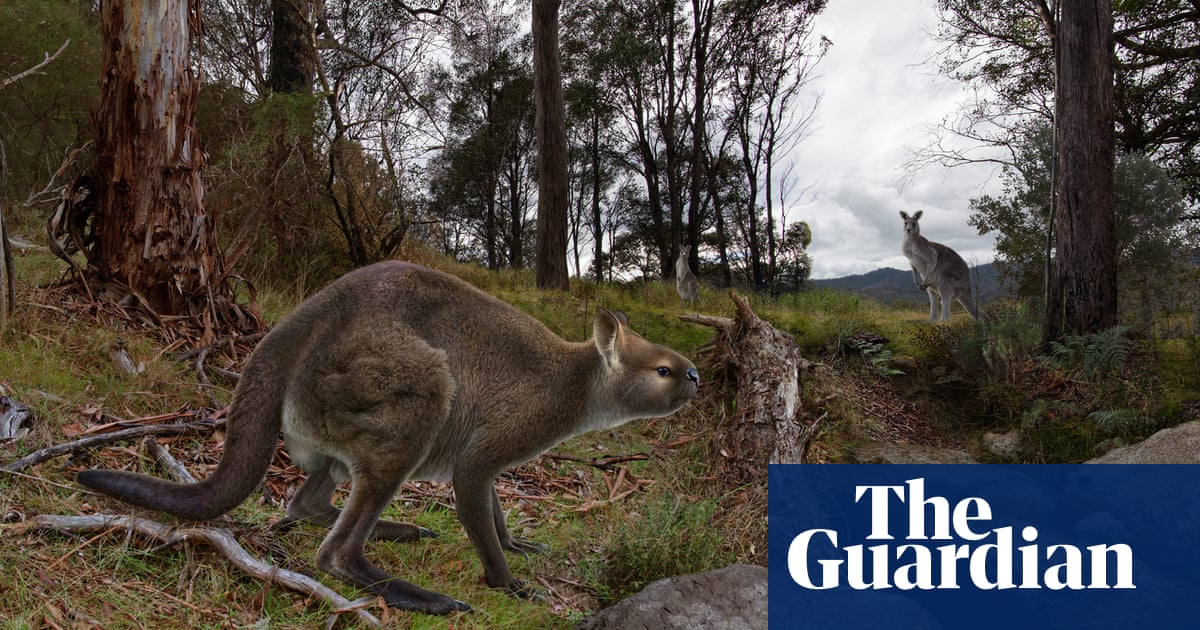When a caver and Gippsland local, Joshua Van Dyk, stumbled across the fossilised remains of a kangaroo species that had been extinct for about 46,000 years, it seemed as though the macropod was making eye contact with him.
“It had fallen behind some rocks … and was looking straight at me,” Joshua recalls of the 2011 discovery he made in a cave near Buchan in east Gippsland.
“I knew it was something significant … especially as I could see a lot more of the body behind the skull.”
A decade later scientists at Museums Victoria have recovered the remaining skeleton of what they now know was a young Simosthenurus occidentalis, also known as the short-faced kangaroo.
They suspect the animal died after falling into a concealed cave entrance a couple of thousand years before the species went extinct.
The fossil is one of the most intact skeletons of an extinct animal found in Australia, and the most complete skeleton found in a Victorian cave. It retained 71% of the animal’s bones, only missing small parts of the paws.
Tim Ziegler, a Museums Victoria Research Institute palaeontologist who led the excavation, says fossils of “this quality and completeness are extremely rare in Australia”.
It’s discovery is helping unlock the secret lifestyle of this long extinct animal.
“We can now learn what they were capable of doing,” Ziegler says.
There is only one short-faced kangaroo fossil as complete as the Buchan fossil, recovered about 50 years ago in South Australia.
Ziegler says the expedition was one of the most physically challenging he has undertaken and involved working in extremely cramped underground space.
Due to the narrowness of the cave, members of the excavation team sometimes had to verbally guide another person’s hands. Ziegler remembers that he also removed overlying sediment before retrieving each bone – there were 150 – by touch.
“The incredible unlikeliness of having this preserved for so long created a real sense of responsibility in bringing it to the surface.”
It’s believed the short-faced kangaroo, which lived alongside modern-day kangaroos, more closely resembled other animals.
after newsletter promotion
The kangaroo had a squarish head and a robust lower jaw, like koalas and pandas, which allowed it to digest matter such as leaves and branches. The juvenile’s skull was the same size as an adult human.
Its shoulders had a “great deal of flexibility”, similar to humans and chimpanzees, Ziegler says. It’s also believed they walked rather than hopped.
“The short-faced kangaroos illustrate a whole other way of living among Australian marsupials that is unlike anything today.”
Short-faced kangaroos were roughly the same height as modern kangaroos but they were much heavier. Scientists estimated the weight of the juvenile kangaroo to be more than 80kg – the weight of a fully grown male red kangaroo. They believe adult short-faced kangaroos weighed up to 120kg.
Gavin Prideaux, the director of palaeontology at Flinders University, says the discovery highlights that “people who are caving and exploring new passages can sometimes make really amazing discoveries”.
“It’s a really, really, good find … it gives us more information about [the extinct animals’] anatomy, biology, what ecological role they played and how they moved.”
The short-faced kangaroo was affected by a major extinction event that wiped out 85% of large-bodied mammals, reptiles and birds.
Ziegler says constant cooling and drying of the environment, habitat loss, disease, and human practices such as increased fires may have been factors that drove them to extinction.
He notes that powerful, short-faced kangaroos were once among the continent’s most widespread and successful marsupials.
“Their abrupt extinction alongside nearly all of Australia’s megafauna is a profound reminder to defend our modern environments against loss.”







